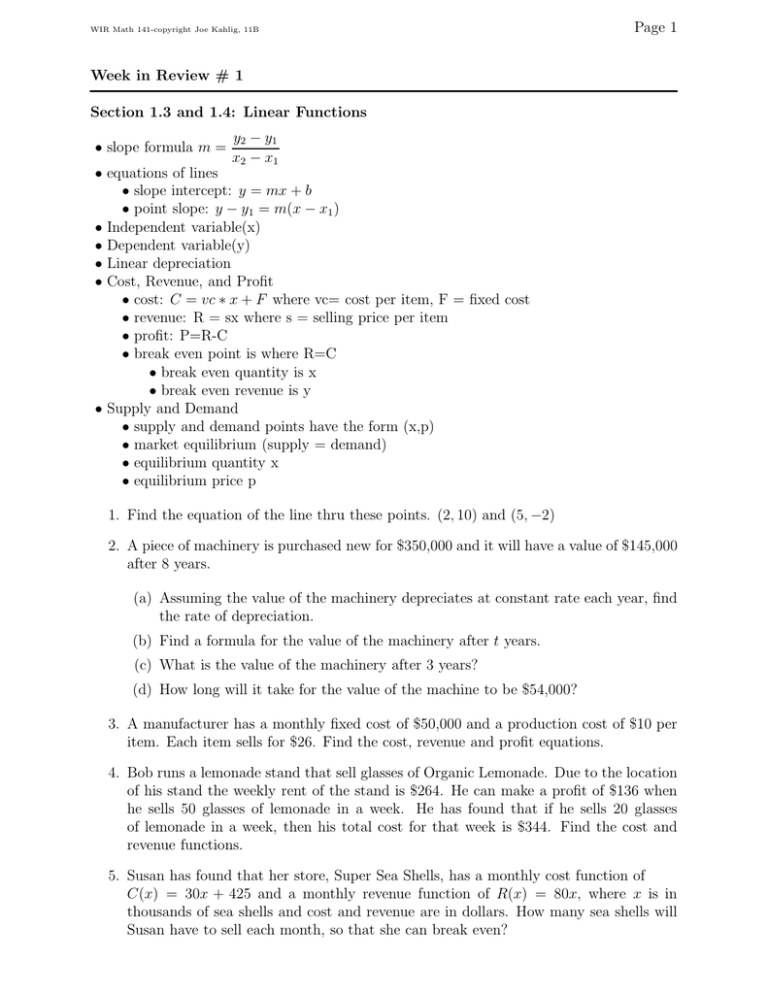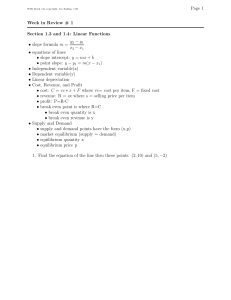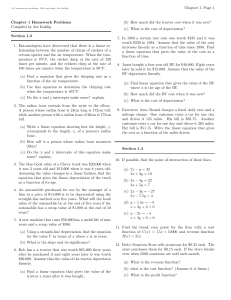Page 1 Week in Review # 1 y
advertisement

WIR Math 141-copyright Joe Kahlig, 11B Page 1 Week in Review # 1 Section 1.3 and 1.4: Linear Functions • slope formula m = y2 − y1 x2 − x1 • equations of lines • slope intercept: y = mx + b • point slope: y − y1 = m(x − x1 ) • Independent variable(x) • Dependent variable(y) • Linear depreciation • Cost, Revenue, and Profit • cost: C = vc ∗ x + F where vc= cost per item, F = fixed cost • revenue: R = sx where s = selling price per item • profit: P=R-C • break even point is where R=C • break even quantity is x • break even revenue is y • Supply and Demand • supply and demand points have the form (x,p) • market equilibrium (supply = demand) • equilibrium quantity x • equilibrium price p 1. Find the equation of the line thru these points. (2, 10) and (5, −2) 2. A piece of machinery is purchased new for $350,000 and it will have a value of $145,000 after 8 years. (a) Assuming the value of the machinery depreciates at constant rate each year, find the rate of depreciation. (b) Find a formula for the value of the machinery after t years. (c) What is the value of the machinery after 3 years? (d) How long will it take for the value of the machine to be $54,000? 3. A manufacturer has a monthly fixed cost of $50,000 and a production cost of $10 per item. Each item sells for $26. Find the cost, revenue and profit equations. 4. Bob runs a lemonade stand that sell glasses of Organic Lemonade. Due to the location of his stand the weekly rent of the stand is $264. He can make a profit of $136 when he sells 50 glasses of lemonade in a week. He has found that if he sells 20 glasses of lemonade in a week, then his total cost for that week is $344. Find the cost and revenue functions. 5. Susan has found that her store, Super Sea Shells, has a monthly cost function of C(x) = 30x + 425 and a monthly revenue function of R(x) = 80x, where x is in thousands of sea shells and cost and revenue are in dollars. How many sea shells will Susan have to sell each month, so that she can break even? WIR Math 141-copyright Joe Kahlig, 11B Page 2 6. A stadium has found that if the ticket prices are $10 per ticket then 3000 people come to the game. If the tickets are priced at $5 per ticket, then 8000 people come to the game. (a) Find the demand equation for tickets to the game. (assume it is linear.) (b) If the supply equation is p = 0.004x + 5, find the equilibrium point. 7. The quantity demanded of a certain brand of tennis racket is 5000/week when the unit price is $250 per racket. When the price decreases by $50 then the quantity demanded is 8000/week. The suppliers will not market any rackets when the price is $100 or below and will make available 3000 rackets when the price is $175. The supply and demand equations are know to be linear. (a) Find the demand equation. (b) Find the supply equation. (c) Find the equilibrium price. (d) Find the equilibrium quantity. Section 1.5: Linear Regression or The method of least squares • Use the regression feature on the calculator 8. The table shows the world record times for the one mile run for the years 1975 to 1999.1 year time(seconds) 1975 1975 1979 1980 1981 1981 1981 1985 1993 1999 231 229.4 229 228.8 228.53 228.4 227.33 226.31 224.39 223.13 Find the best fit line. 9. A sample of nine adult men gave the following data on their heights and weights. Height(inches) Weight(pounds) 63 66 67 68 68 70 70 72 76 140 145 185 180 165 195 215 220 240 (a) Find the linear regression equation for the data. (b) Using the regression equation, predict the weight of a man that is 67 inches tall. (c) Using the regression equation, predict the height of a guy that weighs 235 pounds. 1 The MAA Mathematical Sciences Digital Library. http://mathdl.org/







